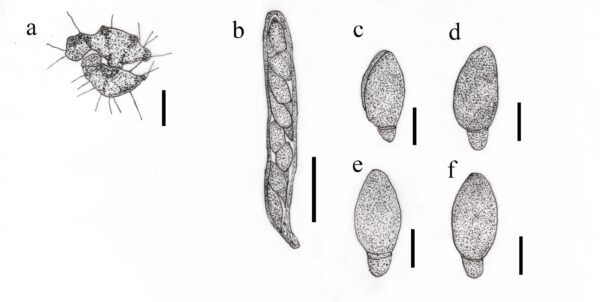Fungalpedia – Note 124 Setoapiospora
Setoapiospora Mapook & K.D. Hyde
Citation when using this entry: Shah et al., in prep – The new genera and higher taxa described in 2020. Mycosphere.
Index Fungorum, Facesoffungi, GenBank, Fig 1
The monotypic genus Setoapiospora was introduced by Hyde et al. (2020), isolated as saprobe from dead wood found in a waterfall in Thailand. Setoapiospora is is known only from its sexual morph. It has submersed, scattered, or sparsely distributed ascomata and appears as dark brown to black spots without uniform margins. The centrally located ostiole has dark-brown setae. The peridium is dark brown with cells of densely compact textura epidermoidea. The hamathecium may be thread-like or cylindrical and distinctly septate. Asci are bitunicate, slightly curved, containing eight spores with an ocular chamber. Ascospores are one seriate, hyaline, wide at the center, and tapered at the ends with numerous granules. It may have a slightly curved and constricted septum. The asexual morph remains unknown. Based on morphological and multigene (ITS, LSU, SSU, and Tef1-α) phylogeny, Setoapiospora is accepted in Muyocopronaceae.
Type species: Setoapiospora thailandica Mapook & K.D. Hyde
Figure 1 – Morphological characteristic of Setoapiospora thailandica (redrawn from Hyde et al. 2020) a Ascomata structure. b Structure of asci. c-f Ascospores. Scale bars: a, b = 50 μm, c-f = 10 μm.
Reference
Hyde KD, Dong Y, Phookamsak R, Jeewon R et al. 2020 – Fungal diversity notes 1151–1276: taxonomic and phylogenetic contributions on genera and species of fungal taxa. Fungal diversity 100, 5–277.
Entry by
Sujit Shah, Center of Excellence in Fungal Research, Mae Fah Luang University, Chiang Rai 57100, Thailand
(Edited by Roberto Farias & Kevin D. Hyde)
Published online 22 September 2023
